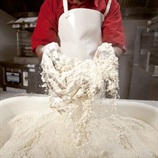KFC is super popular in South Africa. It’s the go-to place for fried chicken, and who doesn’t love a spicy Zinger burger or wrap – my favourite thing on the menu. When I was invited to go behind-the-scenes at a KFC restaurant recently I was keen to check it out as fast food generally has a bad rap and I was interested to see what actually happens in a KFC kitchen, rather than believing everything I read on the internet. So here I was in one of the KFC kitchens, ready to see firsthand what happens there.
I always used to think of fast food kitchens as grubby. When I was invited to go behind the scenes at this KFC restaurant, I was very pleasantly surprised and at first thought that they must have just renovated their kitchen and wanted to do a bit of showing off. However, it turns out the kitchen has been in use for years, it was just very clean and well maintained.
KFC has a strict cleaning and sanitation programme for all food contact surfaces, including hands. In South Africa wearing gloves when preparing food is not required by law, and KFC’s policy of washing hands every 30 minutes, or when dirty, seems more effective.
I was also very keen to hear where KFC sources its chickens from, as all sorts of stories and myths abound the internet, and I was eager to see myself what processes they use. While KFC chicken is not free-range, it’s not battery chicken either. KFC sources the majority of its chicken from Rainbow Chicken Farms, the same company that supplies leading retailers. The chickens are not caged; they are free to roam the chicken house. The chickens self-feed on a scientifically controlled diet, free from hormones and steroids, as per the regulations for all South African chicken. Antibiotics are only approved for veterinary purposes to manage the health of chickens and in cases where antibiotics are used there are strict controls and withdrawal periods in place to guarantee that there are no antibiotics in the meat by the time the chicken is processed.
KFC cooking oil is free from trans fatty acids and is checked regularly and replaced as necessary. Used oil is disposed of responsibly.
Every new KFC employee, regardless of their role in the organisation, has to work in a restaurant for two weeks, and this creates a love for the product and respect for the brand. For team members who work in the restaurant, it takes 90 days of training before they are able to produce KFC signature recipes. We compared the chicken preparation and breading skills of the pro to a fellow journalist. The pro knew all the tricks, from rinsing and thoroughly checking each piece, to double breading the drumsticks and folding the wings carefully before cooking.
I was very happy to note that KFC also has a clock system whereby the shelf life of each type of product is monitored. Each item of food in the kitchen is time-coded and if it is not sold within a set time, it will be discarded.
Lastly it was great to hear out their social responsibility. Add Hope is KFC’s Corporate Social Responsibility initiative. It was started in 2009 and has raised over R210 million to feed children in South Africa.
KFC also promotes an active lifestyle through the KFC Mini-Cricket programme, with over 100 000 South African’s partaking.
So, what is it that makes KFC so addictively finger licking good? The Colonel’s blend of 11 herbs and spices which still remains a closely guarded secret, carved out on the back of his kitchen door. Today that recipe makes KFC the world’s most popular chicken restaurant.
Do you have love for fried chicken?

